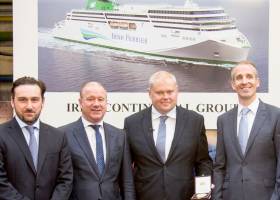Displaying items by tag: Keel Laying
Strong Irish Ferries Presence at Keel Laying Ceremony
A delegation of senior Irish Ferries officials today attended the keel laying ceremony for a new €144million, 55,000 tonnes cruise ferry being built on behalf of the company in Flensberg, Germany.
Due to be delivered next July, the new vessel will be the largest and most luxurious ferry ever to sail on the Irish Sea. It will enter year-round service on the Dublin – Holyhead and Ireland – France routes.
On board, it will have space for 1,885 passengers and crew, 440 cabins including luxury suites with their own private balconies, and almost 3km of car deck space. Other facilities will include a Club Class lounge with direct passenger access from the car decks, á la carte and self-service restaurants, cinema, shopping mall, choice of bars and lounges, exclusive areas for freight drivers, and dedicated facilities for pets.
In accordance with tradition on such occasions, Andrew Sheen presented the shipyard with a ceremonial coin, specially commissioned by Irish Ferries to mark the occasion, which was placed within the keel section to remain there throughout its construction in order to bring good luck and calm seas for the vessel.
Afloat.ie readers have being suggesting names for the new ferry here, 'Seamus Heaney' is a popular choice and 'Brian Ferry' gave us a chuckle





























































